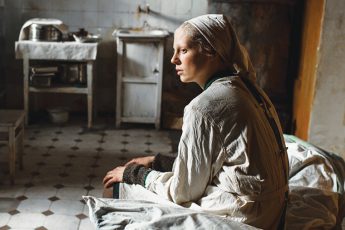The Drake and the Wild Goose
Natasha Merkulova and Aleksey Chupov’s The Man Who Surprised Everyone (Tchelovek Kotorij Udivil Vseh, 2018)
Vol. 98 (October 2019) by Anastasia Eleftheriou
Forest guide Egor (Yevgeny Tsyganov) and his wife Natalya (Kudryashova) live quietly in a small Siberian village. Natalya is pregnant with their second child when Egor breaks the news of his impending death per a very advanced tumor for which there is no cure. At first the film seems like a well-played atmospheric family drama of the Russian tradition – with life’s somber fold woven into nature’s imposing presence. Natalya’s efforts to find money and a cure for Egor prove to be in vain and soon the whole village knows about his fatal condition. Egor, in yet another Russian motion, is proud, however, and accepts his death with sacrificial bravado. He wants to be left to die peacefully. As a last resort, Natalya takes Egor to a forest witch-guru, a sort of alternative therapist who tools with exorcism for relief. Although this particular practice does not seem to work, the forest-witch invites Egor for some Vodka and recounts a Siberian folk-legend about Zhamba the drake; when Zhamba found out that he was dying, he decided to disguise as a female duck to cheat Death so that Death would not find him and take him away. The legend is the basis of the story that the young directors, Natasha Merkulova and Aleksey Chupov, wish to tell in their second feature The Man Who Surprised Everyone. Folk legends and fairy-tales, simplistic as they might seem, have always integrated into their narratives sets of social commentaries on human behavior, morals and values.
In a very surprising change of narrative and atmosphere, Egor decides to buy female clothes and make-up and starts dressing like a woman. His change of gender identity is met with disdain, however, and his child is bullied at school for having “a fag” for a father. In a tragic gesture that signals his wife’s acceptance of social exclusion, she forces him to hide in the stable, wishing he could “die normally”. As the villagers’ tolerance towards Egor wanes, finally shifting to outright violence, he leaves the stable, fleeing into the forest and wandering the countryside, from whence the film truly turns New Testament. The only silent figure showing understanding is his wife’s father (who lives with them in the house, in Natalya’s eyes turning more and more into a “burden”). The old man is the one who releases Egor from the villagers who beat him up for being dressed up like a woman. Does Egor’s choice help him hide from Death? The question Merkulova and Chupov are asking seems to lie elsewhere. As Egor’s way to Calvary unfolds, sequences of several squeaking ducks – in the village, in the farm, in the fields – recall the folk-legend of Zhamba. Their high-pitched cries are extremely uncomfortable; it feels like Death is already among them, torturing them to unveil which one of them is the drake. And a as matter of fact, as the story is drawing to a close, we can no longer tell the drake from the duck. Is Egor pretending to be a woman to escape Death, or has he finally found the strength to express his true sexuality?
As in any good story about castigation within a community, and more specifically about castigation and sexual change (from Virginia Woolf’s Orlando to Herculine Barbin’s Diaries, or Panos Koutras’ Strella in recent cinema), the experience of social exclusion is depicted through society’s behavior towards and anger with whoever is different. The rejection of Egor as a woman is a rejection of his freedom to be a full member of society, and the moral frame that makes it permissible to take his freedom away is a projection of society’s contradictions. Whoever opens pandora’s box of difference and reveals these fears, will be punished and excluded.
In Virginia Woolf’s Orlando (1928), the main character inexplicably turns from male to female and remains young throughout the centuries, experiencing gender symbolisms, projections and social injustices first-hand. Woolf’s literature provided a beautiful foundation for depicting gender changes and suffering in cinema, as the natural elements surrounding the main character reflected his or her transformation. Orlando demonstrates, in the unique, sharp and sarcastic manner of Virginia Woolf, that not only the transformation of sexes, but the female sex itself is not subjected to the same fate as the male sex. In Woolf’s book, one of the main recurring elements is a wild goose that Orlando keeps running after. Whether that goose is a symbol for life, death, failure or unfulfilled dreams is open to different interpretations. However, in Natasha Merkulova and Aleksey Chupov’s film, the drake serves as a symbol for Egor, or as a practical symbolic thread that keeps the narrative together even when a lot of time is spent following the emotional development of the main character in scenes devoid of action. And despite the specific location – today’s rural and conservative Russia -, the story remains global. Some might rush and see two Russian filmmakers condemning the gender politics and sexual norms of their country. But they might be fooled. For as true as that might be, Orlando wandered around for centuries, from West to East. Egor is wandering around the Siberian countryside, but just like Orlando, he could be found anywhere today. After all, little has changed in the way we love to come together to stigmatize and exclude individuals as a means of finding meaning and coherence in our hypocritical morals. Not much has changed in the way patriarchy applies sexual violence in an effort to re-establish itself when masculinity is called into question. Individuals might still run after the wild goose, that eternal quest for fulfillment, but when Death comes, the drakes will still disguise as ducks, trying to hold on to their lives; yet in real life, that final disguise can no longer avert their fate.




Leave a Comment